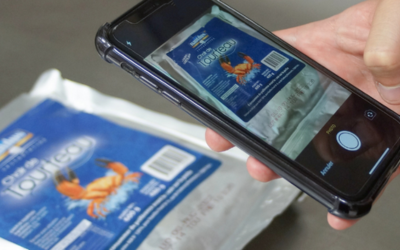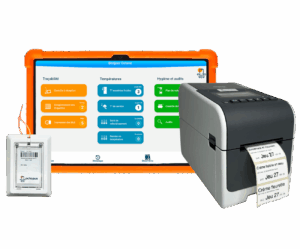Mastering food traceability in the foodservice industry
Food traceability consists of tracing the journey of foodstuffs from their origin to their consumption. It ensures food quality and safety, compliance with current regulations, and highlights the expertise of chefs. In this article, we will explain how to ensure food traceability in your restaurant, which tools and methods are at your disposal, and what benefits you can gain from it.
Master traceability with our HACCP guide.
Principles of food traceability in the restaurant industry ?️
Food traceability is the ability to trace all information related to a food product, from production to distribution including processing.
It is mandatory for all restaurant professionals since Regulation EC 178/2002 of January 28, 2002, which sets procedures related to food safety. It is one of the essential components of the HACCP method.
Food is not something to take lightly—your mother already knew that.
In restaurants, food traceability is done upstream, internally, and downstream if you sell to other professionals.
Upstream traceability involves identifying all suppliers who have provided foodstuffs or raw materials used in the restaurant. Practically, you must keep all your delivery notes and be able to identify where your goods come from. You also have to check the quality of the delivered food products, because if you notice a defect (damaged goods, non-compliant temperature, expired date), you must refuse the merchandise. Once a product enters your restaurant, you are responsible for it!
Internal traceability is the ability to track the journey of food products within the establishment, from receipt of raw materials and ingredients to the sale of finished products.
Within the HACCP method, this is probably the most tedious part in restaurants! So what do you actually have to do?
At a minimum, you will be asked to keep traceability information for the ingredients you use every day. This means you must be able to retrieve, for each service, the list of ingredients used, along with their batch number and expiration or best-before date. How? You can cut out your traceability labels and keep them for 6 months for expiration dates and up to 5 years for best-before dates, or use a HACCP app to photograph and automatically store them. You also need to be able to list all allergens present in your preparations to properly inform your customers.
But internal traceability does not stop there, because you must be able to follow the path of your ingredients or preparations. If a product is unpacked or transformed and then stored, you must label it. The food traceability information that must appear on the label includes: product name, opening or manufacturing date, secondary expiration date.
If you want to know everything about internal traceability in restaurants, I invite you to read this comprehensive article on mastering food traceability.
Downstream traceability involves identifying all professional customers who have purchased your finished or semi-finished products. Downstream traceability is mandatory if you have a production laboratory or a central kitchen in collective catering. But it is also mandatory if you produce foodstuffs within your restaurant and deliver another restaurant, a market sales point, a food truck, etc. This applies even if you own the other establishments.
In this case, you must keep your delivery notes, identifying the products delivered and the quantities. Also be vigilant about labeling these foodstuffs! If you deliver packaged foodstuffs, you must have health stamps.
Which method to ensure food traceability? ?
The tools and methods to ensure food traceability have evolved over time. ‘Old school’ techniques such as cutting and storing traceability labels, or handwriting secondary expiration dates have given way to HACCP applications.
The digitalization of the HACCP method has saved restaurateurs time in their daily operations. The Octopus HACCP app is an example of a useful solution to ensure food traceability. The Octopus HACCP app is suitable for traditional restaurants. It allows you to perform your upstream, internal, and downstream traceability in just a few clicks and print your secondary expiration date labels. But that’s not all, Octopus HACCP also helps you create your custom cleaning plan, and quickly carry out your temperature recordings. In short, it saves you time!
- To ensure food traceability in restaurants, you can:
Cut out your traceability labels: if you love scissors and storage pockets, be sure to keep the right information! The barcode, if it’s an EAN 13, won’t give you the necessary traceability information. You need to keep: the product name, batch number, and expiration date. If it’s an expiration date (DLC), keep the label for 6 months; if it’s a best-before date (DDM), you must store it for 5 years! - Use a HACCP application on mobile or tablet: food traceability apps like Octopus HACCP are powerful tools to ensure traceability because they save you time and make it very easy. With one photo, you keep the product name, batch number, and expiration date. Photos are automatically sorted and archived!
How can I be sure I am properly doing food traceability?
- Audits: You can commission a HACCP professional to carry out audits in your establishment. These are assessments of regulatory compliance. Audits verify that your restaurant meets requirements regarding food traceability and HACCP regulations in general. Audits can be conducted by independent third parties.
- Inspections: During an inspection, the inspector will ensure that you carry out your food traceability and that it complies with regulations. Inspections are often performed by government inspectors from the DDPP of your region. They are not there to bother restaurateurs but to ensure restaurants respect food safety standards.
During an audit or official inspection, you will be asked, among other things, to find traceability information for your production on a given date. The paper label does not need to be physically presented; a photo of the information is sufficient.
Benefits of mobile food traceability ?
Traditionally, food traceability was documented on paper, but more and more restaurants are adopting digital solutions such as apps like Octopus HACCP to manage this task.
Here are some reasons why food traceability on a HACCP app can be preferable to paper documentation:
- Speed and simplicity: with a HACCP app, information can be recorded, sorted, and retrieved faster and easier than paper documentation. No more cutting out labels, cleaning, and filing them. And during an inspection, searching for a specific date in 20 binders—what a hassle! This allows restaurants to save time and be more efficient in managing recalls and requests in case of inspection.
- Accuracy: the app can help reduce errors and omissions by including checklists and predefined choices to facilitate data entry.
- Accessibility: accessible from multiple locations, from a computer or mobile device, and allowing authorized users to enter and retrieve traceability information anytime and anywhere—that’s the freedom Octopus HACCP offers you.
Using a HACCP app to document food traceability can help improve speed, accuracy, and accessibility of information. In short, you save time and stay calm during hygiene inspections.
As you’ve seen, food traceability in the restaurant industry is a major issue and a legal obligation.
Our app will help you guarantee every step of this traceability.
The Octopus HACCP app saves you time and improves speed and accuracy in managing your restaurant’s traceability.
In case of hygiene inspection, you are worry-free; all your documents are available on the app. At any time, you can access all your photos and traceability elements.
Want more info on the topic? Check our article to better understand the HACCP method.



